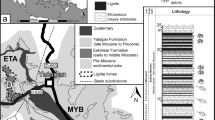Abstract
A rich and diversified palynofloral assemblage has been recovered from the Kopili Formation exposed at 136 km post on Jowai-Badarpur Road, Jaintia Hills, Meghalaya, India. Besides the gymnospermous and angiospermous pollen and pteridophytic spores, the palynofloral assemblage also contains dinoflagellate cysts, fungal remains, bryophytic spores and reworked Gondwana palynofossils in good amount. Based on the distribution and habitat of the extant counterparts of recovered palynofossils, eight plant complexes have been recognized. Most families represented in the assemblage are presently distributed in the tropical to sub-tropical regions indicating almost similar climatic conditions during the deposition of Kopili sediments. The palynofloral assemblage indicates coastal to marine depositional environment with minor oscillations of sea, having fresh water connections with swamps and ponding conditions nearby.
Similar content being viewed by others
References
Baksi S.K. (1962) Palynological investigation of Simsang River Tertiaries, South Shillong Front, Assam. Bull. Geol. Min. Metall. Soc. India, v.26, pp.1–22.
Banerjee D., Misra C.M. and Koshal V.N. (1973) Palynology of the Tertiary subcrops of Upper Assam. Palaeobotanist, v.20(1), pp.1–6.
Das P.K., Joychandra Singha L. and Sharma A. (2001) Stratigraphy and sedimentation of the Lower Tertiary sediments around Sonapur-Lumshnong area, Jaintia Hills, Meghalaya, India. Him. Geol., v.22 (2), pp.55–60.
Dasgupta A.B., Evans P., Metre W.B. and Viswanath (1964) Excursion No. A17 and C14. 22nd Int. Geol. Congr., New-Delhi.
Dutta S.K. (1976) Tertiary palaeogeography of North Eastern India. Geophytology, v.6(1), pp.65–74.
Dutta S.K. (1982) Tertiary stratigraphy of Upper Assam. Jour. Palaeont. Soc. Ind. Spec. Publ., No.1, pp. 65–83.
Dutta S.K. and Jain K.P. (1980) Geology and palynology of the area around Lumshnong, Jaintia Hills, Meghalaya, India. Biol. Mem., v.5, pp.56–81.
Mathur L.P. and Evans P. (1964) Oil in India. 22nd Int. Geol. Cong., New Delhi, pp.1–85.
Mehrotra N.C., Saxena R.K. and Sharma J. (2000) Palynological interpretation of the Pre-Barail sediments in the UpperAssam Basin, India. Bull. Oil Nat. Gas Comm., v.37(1), pp.145–156.
Sah S.C.D. and Dutta S.K. (1968) Palynostratigraphy of the Tertiary sedimentary formations of Assam:2. Stratigraphic significance of spores and pollen in the Tertiary succession of Assam. Palaeobotanist, v.16 (2), pp.177–195.
Salujha S.K., Kindra G.S. and Rehman K. (1974) Palynology of the South Shillong Front Part II. The Palaeogene of Khasi and Jaintia Hills. Palaeobotanist, v.21(3), pp.267–287.
Saxena R.K. and Tripathi S.K.M. (1982) Lithostratigraphy of the Tertiary sediments exposed along Jowai-Badarpur Road in Jaintia Hills (Meghalaya) and Cachar (Assam). Palaeobotanist, v.39(1), pp.34–42.
Saxena R.K. and Trivedi G.K. (2009) Palynological investigation of the Kopili Formation (Late Eocene) in North Cachar Hills, Assam, India. Acta Palaeobotanica, v.49 (2), pp.253–277.
Schull B.J., Felix F.J., Mccaleb S.B. and Shaw W.J. (1966) The interdisciplinary approach to palaeoenvironmental interpretation. Trans. Gulf Coast Assoc. Geol. Soc., v.16, pp.81–117.
Sein M.K. and Sah S.C.D. (1974) Palynological demarcation of Eocene-Oligocene sediments in the Jowai-Badarpur Road Section, Assam: In: S.C.D. Sah and A.T. Cross (Eds.): Symposium Stratigraphy and Palynology, Lucknow 1971. Spec. Publ. 3, pp.99–105., Birbal Sahni Institute of Palaeobotany, Lucknow.
Selkirk D.R. (1975) Tertiary fossil fungi from Kiandra, New South Wales. Proceedings Linnaean Society of New South Wales, v.100, pp.70–94.
Singh H.P. and Tripathi S.K.M. (1987) Palynology of the Jaintia Group (Palaeocene-Eocene) exposed along Jowai-Sonapur Road, Meghalaya, India (Part 2). Data analysis and interpretations. Palaeobotanist, v.35 (3), pp.301–313.
Tripathi S.K.M. (1989) Algal and fungal remains from Jowai-Sonapur Road Section (Palaeoceae-Eocene), Meghalaya. Palaeobotanist, v.37(1), pp.63–76.
Tripathi S.K.M. and Singh H.P. (1984a) Two new pollen genera from the Lower Tertiary sediments of Meghalaya, India. Palaeobotanist, v.32(2), pp.153–157.
Tripathi S.K.M. and Singh H.P. (1984b) Palynostratigraphical zonation and correlation of the Jowai-Sonapur Road Section (Palaeocene-Eocene), Meghalaya, India. In: R.S. Tiwari, N. Awasthi, S.C. Srivastava, H.P. Singh and Sharma B.B. (Eds.) Proceedings of the 5th Indian Geophytological Conference, Lucknow, 1983, Spec. Publ., pp.316–328. The Palaeobotanical Society, Lucknow.
Tripathi S.K.M. and Singh H.P. (1985) Palynology of the Jaintia Group (Palaeocene - Eocene) exposed along Jowai-Sonapur Road, Meghalaya, India (Part 1). Systematic palynology. Geophytology, v.15(2), pp.164–187.
Trivedi G.K. (1985) Palynology of the Kopili Formation (Upper Eocene) exposed along Jowai-Badarpur Road, Meghalaya. Jour. Ind. Bot. Soc., v.64(1), pp.66–72.
Trivedi G.K. (1991) Reworked Gondwana palynofossils from the Kopili Formation (Late Eocene) of Jaintia Hills, Meghalaya. Geophytology, v.20(1), pp.66–68.
Trivedi G.K. (2005) Palaeopalynology of Kopili Formation-A Review. In: P.C. Trivedi (Ed.), Applied Botany, Avishkar Publishers, Distributors, Jaipur (Rajasthan), India, pp.183–189.
Trivedi G.K. (2009) Palynofloral diversity in the Kopili Formation (Late Eocene) from north-east India. Acta Musei Nationalis Pragae Series B- Historia Naturalis, v.65(1-2), pp.9–24.
Trivedi G.K. and Saxena R.K. (2000) Palynofloral investigation of the Kopili Formation (Late Eocene) exposed near Umrongso in North Cachar Hills District, Assam, India. Palaeobotanist, v. 49(2), pp.269–280.
Author information
Authors and Affiliations
Corresponding author
Rights and permissions
About this article
Cite this article
Trivedi, G.K., Ranhotra, P.S. Palynofloral evidence for palaeoecology and depositional environment of the Kopili Formation (Late Eocene), Jaintia Hills, Meghalaya. J Geol Soc India 86, 33–40 (2015). https://doi.org/10.1007/s12594-015-0278-4
Received:
Accepted:
Published:
Issue Date:
DOI: https://doi.org/10.1007/s12594-015-0278-4




